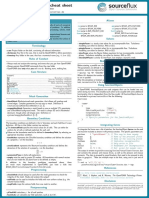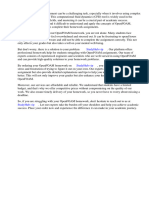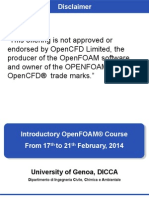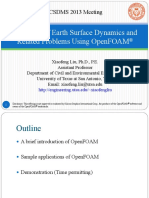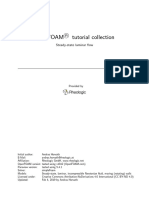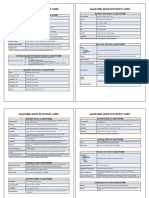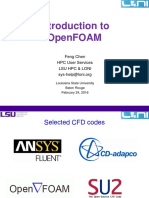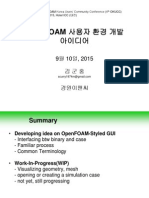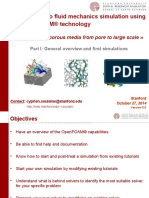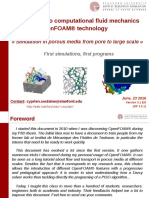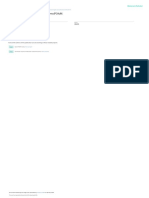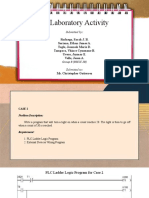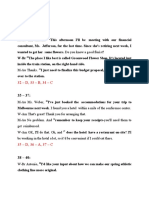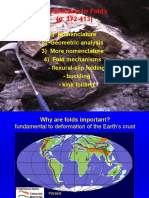OpenFoam Basic Test
OpenFOAM Basic Concepts (30% - 7 questions)
1. What is OpenFOAM primarily used for?
o a) Word processing
o b) Image editing
o c) Computational Fluid Dynamics (CFD)
o d) Database management
2. Which language is OpenFOAM written in?
o a) Python
o b) Java
o c) C++
o d) Fortran
3. What does the “FOAM” in OpenFOAM stand for?
o a) Fast Object-Oriented Application Model
o b) Field Operation And Manipulation
o c) Fluid Operations And Mechanics
o d) Finite Object Analysis Method
4. Which turbulence model is NOT available in OpenFOAM?
o a) k-epsilon
o b) k-omega
o c) k-alpha
o d) Spalart-Allmaras
5. In the PISO algorithm, what does PISO stand for?
o a) Pressure Implicit with Splitting of Operators
o b) Pressure Implicit with Sequential Operations
o c) Pressure Iterative with Splitting Operators
o d) Pressure Iterative Sequential Operation
6. Which of the following is NOT a type of boundary condition in OpenFOAM?
o a) fixedValue
o b) zeroGradient
o c) slip
o d) staticPressure
7. In OpenFOAM, which boundary condition represents a wall where no-slip
condition is applied?
o a) noSlip
o b) fixedValue
o c) slip
o d) zeroGradient
Programming OpenFOAM (30% - 7 questions)
8. Which OpenFOAM dictionary contains discretization schemes for gradient,
divergence, and laplacian terms?
o a) fvSchemes
o b) fvSolution
o c) controlDict
o d) transportProperties
9. In custom function objects, which keyword is used to specify the libraries to load?
o a) libs
o b) functions
o c) operations
o d) methods
10. Which function in OpenFOAM is used to access the internal field of a
volScalarField?
a) internalField()
b) boundaryField()
c) meshField()
d) coreField()
11. To add a custom solver to OpenFOAM, you would primarily modify which
directory?
a) applications/
b) tutorials/
c) src/
d) bin/
12. Which file in OpenFOAM contains the initial and boundary conditions for a
simulation?
a) controlDict
b) transportProperties
c) fvSchemes
d) 0/
13. Which of the following is NOT a type of mesh refinement method in OpenFOAM?
a) Surface refinement
b) Region refinement
c) Edge refinement
d) Color refinement
14. If you want to run a parallel simulation in OpenFOAM, which utility should be run
after decomposing the domain?
a) simpleFoam
b) pimpleFoam
c) mpiSimpleFoam
d) simpleFoam -parallel
Running OpenFOAM (10% - 2 questions)
15. Which command is used to initialize a case in OpenFOAM?
a) foamInit
b) blockMesh
c) foamStart
d) decomposePar
16. Which utility is used to check the quality of the generated mesh in OpenFOAM?
a) checkMesh
b) meshQuality
c) foamCheck
d) meshInspect
Post-processing with ParaView (20% - 5 questions)
17. In ParaView, which filter allows you to visualize streamlines in a flow field?
a) Glyph
b) Stream Tracer
c) Clip
d) Contour
18. Which of the following is NOT a visualization feature in ParaView?
a) Scalar Bar
b) Vector Arrows
c) Histogram
d) Word Cloud
19. To visualize the pressure distribution on a surface in ParaView, you would use:
a) Warp filter
b) Slice filter
c) Contour filter
d) Glyph filter
20. In ParaView, which filter would you use to extract data along a line?
a) Extract Line
b) Plot Over Line
c) Slice Along Line
d) Data Over Line
21. To calculate the vorticity of a flow field in ParaView, which filter should be
applied?
a) Gradient
b) Calculator
c) Vorticity
d) Derivative
Meshing (10% - 2 questions)
22. In OpenFOAM, which utility is used to generate a block-structured hexahedral
mesh?
a) blockMesh
b) foamMesh
c) snappyHexMesh
d) tetraMesh
23. Which meshing utility in OpenFOAM is designed for complex geometries and can
handle both hexahedral and tetrahedral cells?
a) blockMesh
b) foamMesh
c) snappyHexMesh
d) tetraMesh
24. In snappyHexMesh, which keyword dictates the number of refinement levels
around a surface?
a) nRefineLevels
b) layers
c) addLayers
d) refinementSurfaces
25. In OpenFOAM, which utility is used to convert a mesh from another CFD software
format to OpenFOAM format?
a) foamConvert
b) meshTranslate
c) foamToVTK
d) ideasUnvToFoam
